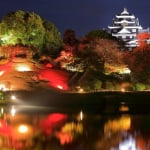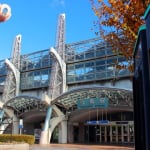Name: Yoshino Suibun Shrine
Address: 1612 Yoshinoyama, Yoshinogun, Nara Prefecture
Access: From Kintetsu Yoshino Station, ride the ropeway to Yoshinoyama Station, then take a bus to Shimosenbon Bus Stop and alight at Kamisenbon Bus Stop; it’s about a 30-minute walk from there.
Visiting Hours: 8:00–16:00
Admission: Free (as of June 2019)
Official/Related Website URLs: http://www.yoshinoyama-sakura.jp/temple/t_mikumari.php
http://www.yokb315.co.jp/index.php
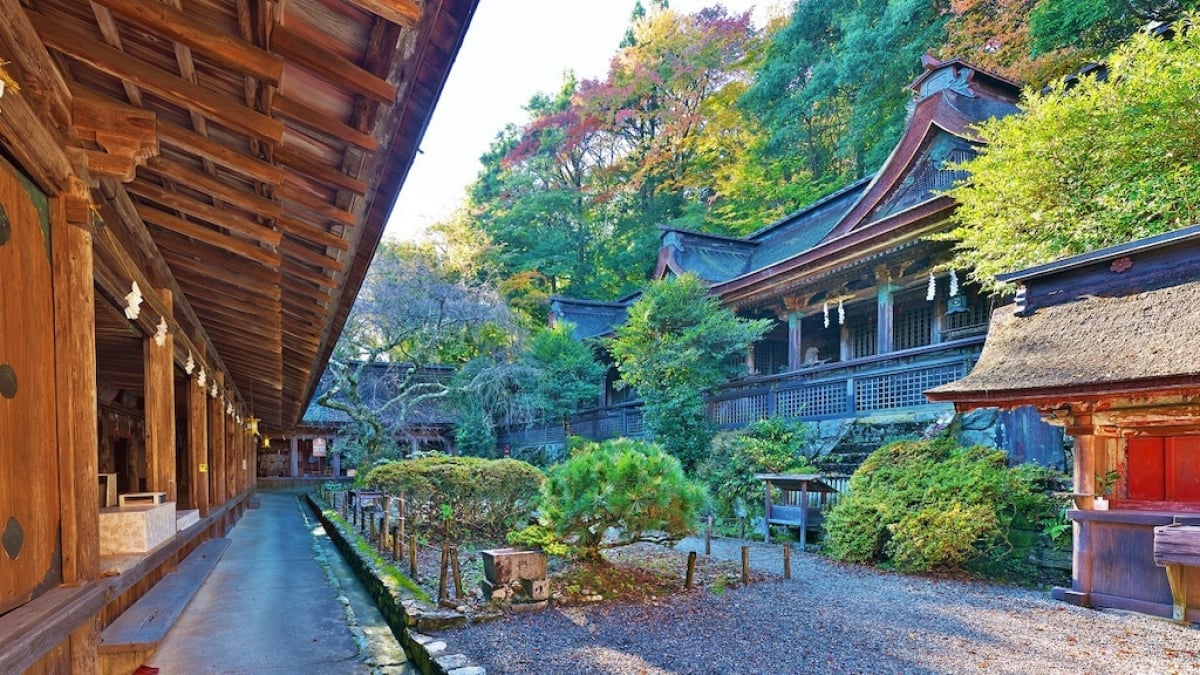
Yoshino Suibun Shrine – A Power Spot Steeped in Myth and History in Yoshino, Nara
Yoshino, located in Nara Prefecture, is a UNESCO World Heritage site famous for its breathtaking views of cherry blossoms and autumn foliage. Surrounded by numerous heritage structures also inscribed as World Heritage, the area leaves a powerful impression on visitors. Although the exact founding date of Yoshino Suibun Shrine is unknown, it was rebuilt in 1604 (the 9th year of the Keicho era) under Toyotomi Hideyori. The shrine’s architectural style reflects the grandeur of the Momoyama period. The shrine complex consists of the main hall (honden), the worship hall (haiden), the offering hall (heiden), the tower gate (roumon), and a cloister, all of which have been designated as Important Cultural Properties. Coupled with the mystical atmosphere of Yoshino Mountain, Yoshino Suibun Shrine is highly popular as a power spot. Be sure to check the access details and information on the autumn foliage when planning your visit.
table of contents
[x] close
Yoshino Suibun Shrine – A Power Spot Steeped in Myth and History in Yoshino, Nara
1. Main Hall (Honden)

The main hall enshrines the principal deity of Yoshino Suibun Shrine, Amenomikumari Ōkami. Originally the god of water, over time “Mikumari” evolved in pronunciation to “Mikomori,” and he came to be revered as the god of fertility. Consequently, many visitors come to pray for safe childbirth and abundant children.
The main hall features a three-structure design with a Kasuga-style central section flanked by two “nagare-zukuri” side sections. Additionally, to the right of the main hall—though not open to the public—a wooden statue of Tamayori-hime, a National Treasure, is enshrined. This further attests to the shrine’s high cultural and historical value.
2. Sakura Gate and Worship Hall
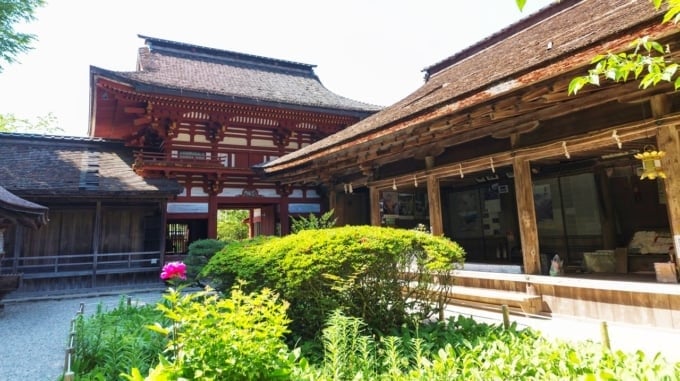
At the shrine’s entrance stands a large vermilion torii. Passing through the torii, you immediately encounter a two-story, roofed tower gate finished in vivid vermilion. In autumn, the stairs between the torii and the tower gate are bordered by brilliant fall colors; in spring, cherry blossoms add beauty; in summer, lush greenery dominates; and in winter, the bright red gate stands out against the white snow. This spot is a favorite for photography among visitors.
Beyond the tower gate, to the left and facing the main hall, is the worship hall where devotees offer their prayers.
3. Cherry Blossoms and Autumn Foliage
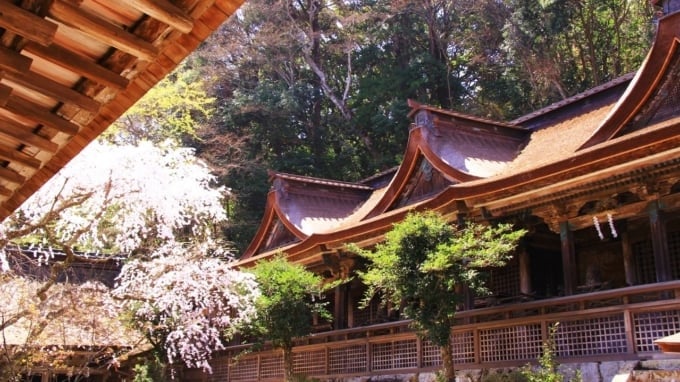
Yoshino Suibun Shrine is renowned as a sightseeing destination for its spring cherry blossoms and autumn foliage. The cherry blossoms typically reach their peak from late March to early April, drawing large numbers of visitors for hanami. The hanging cherry trees (shidarezakura) are particularly famous, and the entire shrine area is awash with blossoms, making it an ideal spot for flower viewing.
Autumn Foliage
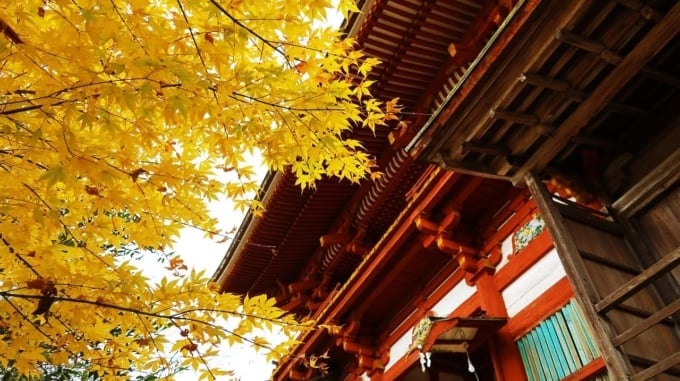
In autumn, the shrine’s surroundings transform into a stunning palette of reds and yellows, captivating the eyes of all who visit. The best viewing period is generally from early to mid-November. However, because the area is quite remote, it is advisable to research transport options and be prepared for a bit of a walk; comfortable clothing and shoes are recommended.
4. Goshuin (Shrine Stamps)
Given the shrine is renowned as a deity of fertility, its goshuin (official shrine stamps) are extremely popular. During the busy seasons of spring and autumn, lines can be very long, so visiting during other times might be preferable. They even offer cute goshuin notebooks—be sure to check them out!
5. Cloister (Kairō)
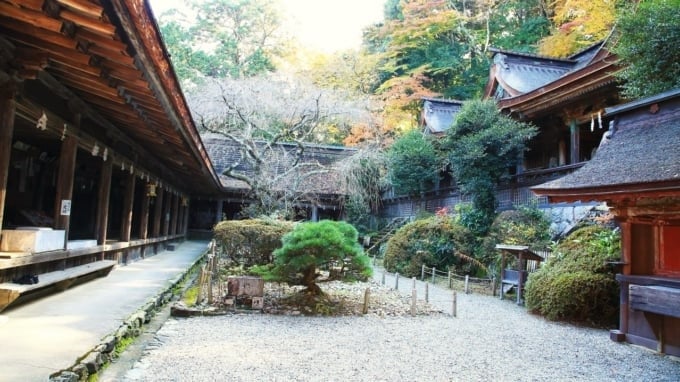
The cloister surrounding the shrine’s courtyard provides a wonderful view, especially in spring when you can closely observe the weeping cherry trees overhead, creating a breathtaking scene as if the blossoms form a natural canopy. The beautifully maintained courtyard also features various seasonal flowers that enhance the overall charm. Since the entire shrine grounds are compact like a miniature garden, it is a pleasure to stroll around and take in every detail.
◎Parking and Access
There is a free parking lot available at Yoshino Suibun Shrine; however, it only accommodates two vehicles. Therefore, it is recommended to park at a suburban lot and then either take a bus or walk to the shrine. If using public transportation, you can ride the Kintetsu Yoshino Line to Yoshino Station, then take the ropeway to Yoshinoyama Station. From there, board a bus at the “Shimosenbon Bus Stop” and alight at “Kamisenbon Bus Stop.” Finally, it’s about a 30-minute walk from there to the shrine. Note that the ropeway operates seasonally, and schedules vary, so be sure to check the official website for up-to-date operating information.
RELATED ARTICLES
REGIONS
CATEGORIES
FEATURED ON osaka
-

From History Museums to Parks: 5 Recommended Tourist Spots in Kadoma City, Osaka Prefecture
-

Thorough Guide to the Highlights and Events at Osaka’s Popular Attraction “Kaiyukan”
-
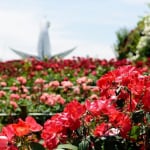
5 must-see tourist spots in Suita City, home to Expo ’70 Commemorative Park! Enjoy tours and hands-on experiences
-

[Kansai] What kind of hotels are ideal for “Hocance”? | Introducing 7 recommended picks
-
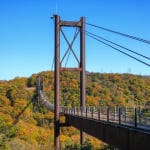
6 Carefully Selected Spots to Fully Enjoy the Rich Nature and Charm of Katano
MOST POPULAR ON osaka
-
 1
1Doha: Must-see Attractions in the Capital of Qatar
-
 2
2Toronto: 10 Things to do in this Picturesque Canadian City
-
 3
3Amarillo: A City Famous for It’s Amazing Canyons, Great History and Music
-
 4
4South Korea: Dazzling Scenery, Rich Culture and Fascinating History
-
 5
5Kuwait: A Country in Middle East Asia Famous for Hot Sand Dunes and Stunning Cityscape


